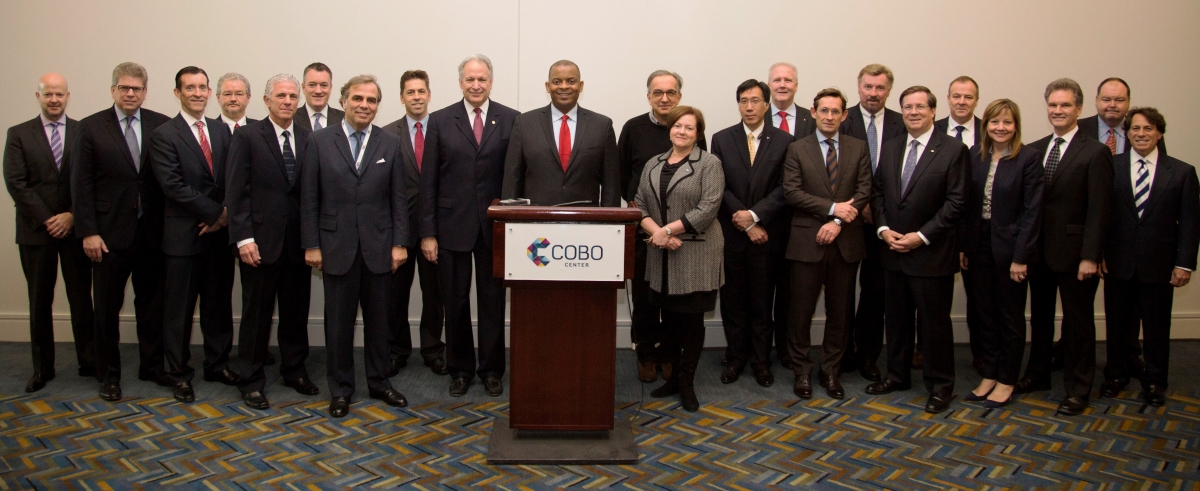DOT, Automakers Agree on Proactive Safety Principles
This is a very exciting time for the auto industry. And I don't just mean the 2016 North American International Auto Show taking place in Detroit.
Yesterday, I announced DOT’s efforts in 2016 to support the safe deployment of autonomous vehicles that carmakers have been developing. And that includes President Obama's proposal to invest $4 billion in pilot programs [external link] to make sure we get it right. And next week, the President will visit Detroit to celebrate a history-making year of record auto sales.

Secretary Foxx walks the Detroit Auto Show with NHTSA Administrator Mark Rosekind.
But there's another side to what is happening in the industry. While we should celebrate the good news, there has been talk of another kind of record: Record numbers of vehicles recalled, and record civil penalties issued by our National Highway Traffic Safety Administration (NHTSA).
Fast Lane readers know the stories. And you might know that Congress recently passed legislation that strengthens NHTSA's enforcement tools. But, you probably also know that real safety means finding and fixing defects before someone gets hurt, rather than just punishing manufacturers after the damage is done.
So that's why I'm excited to announce that, today, DOT and 18 automakers are taking a strong stand --together-- for a new proactive, collaborative approach to safety.

Secretary Foxx, NHTSA Administrator Rosekind with automakers.
We have finalized a historic agreement on a set of broad-ranging actions to help make our roads safer and help avoid the sort of safety crisis that generates the wrong kind of record-setting and headlines. The commitments we make today will help catch safety defects before they explode into massive recalls. They will help improve the quality of data that automakers and NHTSA analyze to identify defects today, and they will find ways to generate better data in the future.
DOT has experience with this kind of approach. In aviation, for example, we already have a model of industry-wide collaboration to support safety. The FAA’s safety management system (SMS) requires a willingness among the airlines to share safety data that can lead to discovering a defect before it hurts anyone. And this has dramatically reduced aviation accidents in our skies.
And, when a recall does become necessary, the commitments we're making today will help us reach consumers and get their vehicles repaired.
Additionally, today’s actions strengthen the industry's efforts to protect vehicle owners from cybersecurity risks. We all know that the performance today's vehicles achieve is due in large part to an increasing amount of computer hardware and software under the hood and behind the dashboard. And the era of automated vehicle technologies we're ushering in will add to that. So we have pledged to work collaboratively to mitigate cyber threats that could pose unreasonable safety risks. We will engage our best cybersecurity minds, share known vulnerabilities and countermeasures, and adopt best practices from within as well as outside of the auto industry.
This coming together of the global automotive industry with DOT and NHTSA to determine how we can make vehicles that are safer than ever before and even safer in the future --this is unprecedented. It was born of us gathering everyone in the same room last fall, and it was the product of an immense amount of work by the companies who have signed onto these principles and by our team at DOT.
It’s a new way of doing business for everybody, and new ways don’t come easily. But that's what you have to do to when the mission you share --making sure Americans can get safely to and from their destination every time they get in their car-- is so important.
You can read this historic agreement at www.transportation.gov/briefing-room/proactive-safety-principles-2016
Consumer research company IHS recently projected that almost 80% of the U.S. population that are of driving age will own smartphones by 2016. We generally know how these devices are used as the average consumer migrates toward a fully connected lifestyle; checking status updates, sending and receiving texts, finding a restaurant, maybe even taking a call or two after posting a new selfie.
The ways these devices are used in a moving vehicle are resurrecting the issue of driver distraction among major media outlets as well as state and federal regulators. Learning of the practical and disparate impact of this usage can provide additional business opportunities for all mobile electronics professionals.
According to Distraction.gov, a Department of Transportation website, there was a nine percent increase in the amount of vehicular injuries from 2011 to 2012 in crashes involving a distracted driver. Yes, you can be distracted while eating a sloppy burger, applying makeup or slapping the kids in the back seat, but this increase is likely due to more people using smartphones and other handheld devices while driving.
The states have taken notice. As of February 2014, the Governors Highway Safety Association (GHSA) reports that 12 states have banned all handheld in-car usage of cellphones and have made this a primary enforcement law, meaning that you can be cited for this offence alone and not in conjunction with another primary offence which was previously the case. In addition, 41 states have outlawed texting and all but four treat this as a primary offense.
What about the practical issues? While driving at 55 miles per hour, sending or receiving a text takes your eyes from the road for an average of 4.6 seconds, the equivalent of driving blind for the length of a football field. 25% of teens respond to a text once or more every time they drive, and 20% of teens and 10% of parents admit to having extended, multi-message text conversations while driving. These are the people who admit to it; imagine the total percentage of drivers out there who are texting right now. You’ve seen them – weaving in a lane, blowing through a red light and braking hard to avoid a collision.
There’s more. The AAA Foundation for Traffic Safety, in a 2012 study, reported that newly licensed female drivers were twice as likely as males to use an electronic handheld device while driving. And in 2011 the Pew Research Center said cellphone owners between the ages of 18 and 24 exchanged an average of 109.5 messages on a normal day. Do you think they kept those smartphones in their backpacks while they drove?
Remember the average age of a vehicle on the road today is 11.3 years, which means over 150 million vehicles are out there that need a hands-free solution and we can assume that a big percentage of those distracted kids are driving those cars. Advanced Bluetooth and voice control products are in your assortment right now, and they should be heavily pushed with the strong message that using a cellphone while driving will get you ticketed just like running a stop sign. Have your customer imagine driving on the Interstate with their eyes closed for about 4 ½ seconds, the equivalent of sending or receiving the average text. Kinda scary, huh?
Getting past the negative sell makes the positive sell much easier. BT audio streaming is a joy once someone discovers it. Hands-free call making and taking isn’t distraction free but it won’t get you pulled over. And it’s a cool new in-dash receiver with a nice display, plus it also charges your phone (or e-cig…whatever) and is affordable – a bonus!
There is no silver bullet here – just a practical, sensible approach to selling safety and convenience. When a majority of your potential customer base is already distracted, they might likely appreciate what you are selling and reward you with their business if you know the facts and communicate the benefits with the understanding that you are not going to change their core behaviors.
We are entering a new era where an increasing number of people are living a connected lifestyle. More than ever, consumers will be seeking ways to improve their connected experience in their homes, in their cars and on the fly. As an industry, we must capitalize on helping customers achieve that experience by turning them on to more innovative, connected products and demonstrating them in ways that are fully relevant to their increasingly connected lifestyles.
Other News
- RDVFL Launches Screen Upgrades for AUDI, BMW and MERCEDES BENZ in Product News
- DD AUDIO PROUDLY RE-INTRODUCES LSS-161 - CLOSE FIELD STUDIO MONITORS in Product News
- RYDEEN UNVEILS THE BL01-MR in Product News
- RDVFL Launches the SDIN6 – A Premium Universal Single-DIN Radio with Wireless CarPlay/Android Auto & 3-Year Warranty in Product News
- Mid City Engineering Announces Remote Start Solution for Mercedes-Benz Vehicles Affected by Mbrace® Shutdown in Product News










